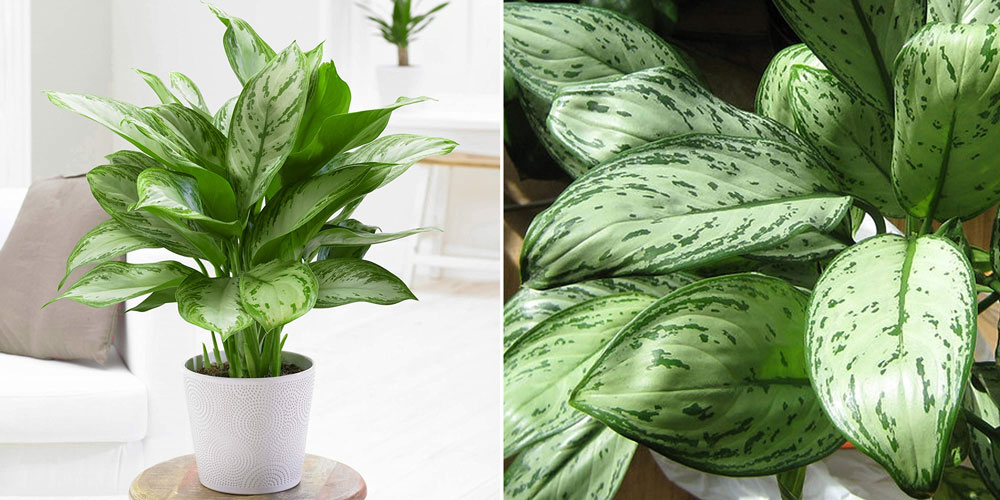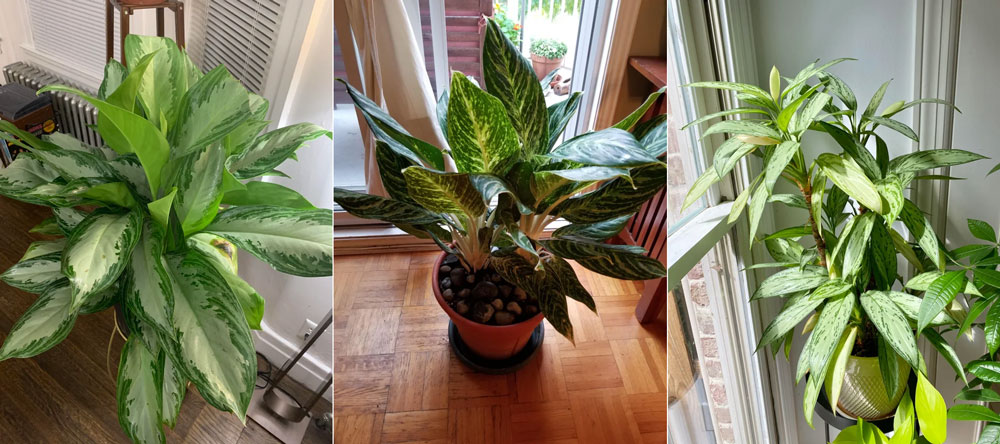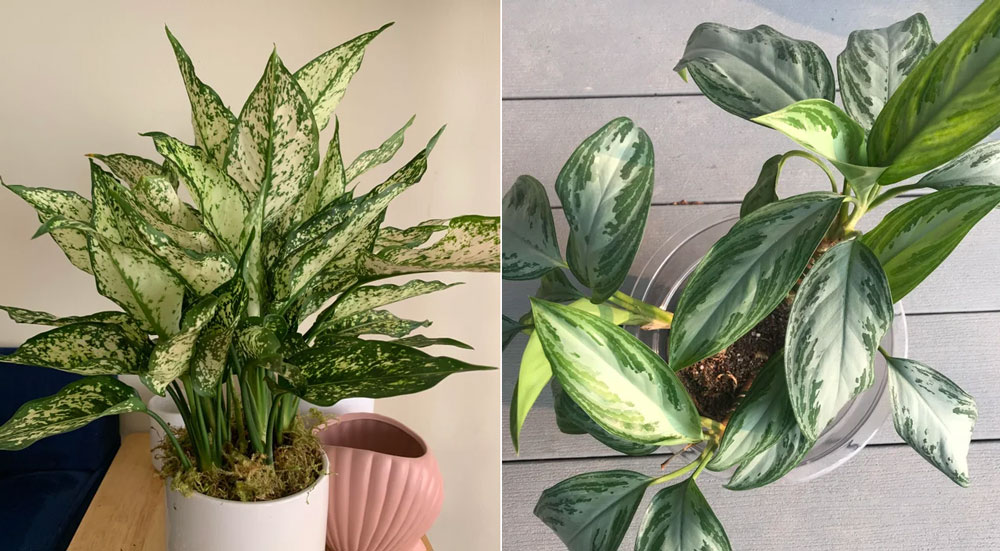Chinese Evergreen Plant – How to Care and Grow the Aglaonema Plants
Whenever you bring up the topic of growing evergreens, first-time gardeners give you a blank stare and grow uneasy. It’s all the maintenance work that makes them think twice about having an evergreen houseplant.
But not the Chinese evergreens. They’re as easy to grow and care for as they come.
One of the hardiest houseplants out there, the aglaonema is also invincible to the elements and damage by nature or man. Neither fluctuating temperature, drought, or varying light will put a dent in Chinese evergreen’s survival instincts.
It’s the type of plant that survives on the bare minimum and always keeps its lush appearance even in a dim-lit room.
The Chinese Evergreen Plant
Native to the tropical forest floors of China and neighboring Asian countries, the Chinese evergreen has about 20 known species. Each species, as we’ll see later, has its own unique set of leaf shapes and colors. This versatility makes the aglaonema the right houseplant for your home no matter what your interior design looks like.
While out in the wild, the Chinese evergreen produces cute little white flowers, indoors, you won’t see these blooms. But that’s no great loss. The large and colorful leaves are all the landscaping you’ll need out of these hardy plants. Some species have lush green leaves, others have silver colors or multi-colored patterns and designs.
The aglaonema shows nature as an artist at its best and most creative. Not to mention cultivars with almost unlimited designs and colors ranging from white and yellow to pink and red. As the leaves grow, they give the plant the shape of a bush. Most species are limited in height and width, although some grow to 3 feet tall.
Varieties of Aglaonema Chinese Evergreen
Not all the 20 species and the many more cultivars are all suitable for your household. Apart from the color and designs, some species are more tolerant of indoor conditions than the others.
Here are the most popular Aglaonema species.
- Aglaonema modestum: With its large green leaves with white outlines, this species is as useful as much as it’s beautiful. Used often to purify the air and remove toxins from indoor enclosures, it’s on NASA’s list of top ten air-filtering plants and natural purifiers. The plant absorbs any pollutants or toxic particles in the air and stores them in its stems.
- Siam Red-Aglaonema: Known for its bright pink and green leaves, nothing gives your home that tropical touch like this evergreen. As a cultivar, it does need more light than other species in that family. But then again, you need to place it in a well-lit room to admire its full splendor.
- Aglaonema- Silver Queen: As the name implies, this plant has silver or cream patterns on deep green leaves. The leaves are more elongated and have more graceful shapes than other species. The dense bush makes this species one of the most grown Chinese evergreens.
- Aglaonema- Silver King: Similar to the Silver Queen, but with larger and bolder patterns. It has its fans, but overall, most people prefer the dainty Silver Queen with its elegant leaves and markings.
- Aglaonema- Emerald Bay: A very darkness-tolerant plant. Its lush green leaves remain bright even if deprived of light for days on end. You see this plant in offices that don’t get lots of light.
- Aglaonema- Suzy: It has the same green leaves with white markings but adds pink veins to give the leaves a distinct appearance. Like the Emerald Bay, it can thrive in dark rooms and offices without a problem.
How to Grow Chinese Evergreens
So this is a plant that doesn’t complain about dim light, can tolerate drought and stays lush and bright even in a dark room. It must be easy to grow the Chinese evergreen then. Which is true, as long as you start it right.
Watering
We said this was a plant that could survive dry soil if you forget to water it. But that doesn’t mean that you should do that. In fact, the Chinese evergreen enjoys moist soil. So water it until water flows out of the drainage holes in the pot. But always make sure the soil is well-drained and not to overwater it. Waterlogging causes root rot and leads to fungal infections.
Soil
Watering and the right kind of soil are both essential for the growth and success of the Chinese evergreen. For good results, you should use a normal potting mix and add a one-third portion of perlite. If perlite is not available, you can use orchid bark mix. Even a slightly acidic soil is good for this evergreen.
Temperature
As a native of tropical forests, high temperature is important for the aglaonema. It might do well in semi-darkness and dry soil, but it cannot tolerate cold weather. So makes sure your room or office is between 60 and 85 degrees F at all times. Below 60 degrees F, the Chinese evergreen stops growing, gets brown leaf tips, and the leaves droop then fall. It also helps to shield the plant from drafts so place it in a corner away from open windows or doors. Changing temperatures also have an unpleasant effect on the aglaonema.
Humidity
While you can control the temperature in your home or office, the same cannot be said about humidity. The Chinese evergreen requires high humidity levels that can only be found in greenhouses and tropical forests. However, to get around that in an airconditioned room, you can spray the leaves with water once or twice a day. If that’s not enough or you don’t have the time to do that regularly, you can place the pot in a tray full of pebbles and water. Just make sure the tray remains full of water to create the right humidity conditions for the aglaonema.
Light
The light needs of your Chinese evergreen vary and depend on the species you have at your home or office. As we have seen some species such as Emerald Bay and Suzy do very well in a dark corner that doesn’t get much light. Even Suzy’s pink patterns remain bright and joyful without access to a good source of light. Other species including the colorful Siam Red Aglaonema need their light just like any other plant.
Chinese Evergreen Plant Care
Once you have your aglaonema up and growing, you’ll have a smooth run from here on out. In general, the three main aspects of care are repotting, pruning, propagation.
Repotting
Usually, you would want to repot your Chinese evergreen once every two years. The root system of the plant is robust and tends to outgrow its current container. If you don’t transfer it to a larger pot, you risk impacting the growth of the aglaonema. Just keep in mind that the pot shouldn’t be too large. Too much soil increases the risk of waterlogging which could be detrimental to the plant’s roots.
To repot the Chinese evergreen, remove it from the current pot. Untangle the roots from the soil and examine them. Any dark roots are rotten and should be removed. Dig a hole in the new pot and lower the plant gently. Cover with a thin layer of soil making sure no roots are exposed. Water the pot immediately.
Pruning
As a versatile and flexible landscaping plant, the Chinese evergreen lets you prune it into any shape you like. Furthermore, you can do away with pruning altogether and leave the aglaonema to grow naturally. It has a natural bush that is a pleasure to look at.
You can also train the plant to grow horizontally instead of vertically. Using your pruning scissors, trim the leaves at the top and leave the ones at the bottom to grow outward. Eventually, the plant will spread out take the shape you prefer.
Propagation
To propagate the Chinese evergreen you can either use a cutting or split the plant during the repotting. To use a cutting, just remove a stem a few inches long from the fully grown aglaonema and plant it in a pot. Cover it with soil, water it, and keep it in a warm room until it develops roots. You could also propagate the stem in water until the roots come out then transfer it to a pot full of soil.
To propagate using separation, split the plant from the roots to get as many plants as you want. You immediately get a fully developed plant that starts growing right away. Put each new plant in its own pot and water it.
Toxicity
We mentioned that the Chinese evergreen purifies the air. It does that by absorbing the toxins and storing them in its stem. That makes the leaves and stems of the plant toxic both for pets and children. So make sure your dog doesn’t chew on the leaves. Keep the pot away from the reach of children and animals.
Pests and Diseases
The two most common issues you might have wit the Chinese evergreens are yellow leaves and brown tips.
- Yellow Leaves: If you notice that the usually lush green leaves of the aglaonema are turning yellow, that could be a result of overwatering. Soggy soil leads to root rot that causes the leaves to turn yellow. Make sure the soil is dry before you water it. In severe cases, you might have to repot the plant, remove all the rotten roots, and start a new plant from the old one.
- Brown Tip: This is another issue that’s related to the water you give the aglaonema. Tap water often contains trace amounts of fluoride. Over time, repeated irrigation leads to the buildup of this mineral in the soil. If you see the tips of the leaves turning brown, that means the soil is saturated with fluoride. You should repot the plant and use either rainwater or distilled water for irrigation.


